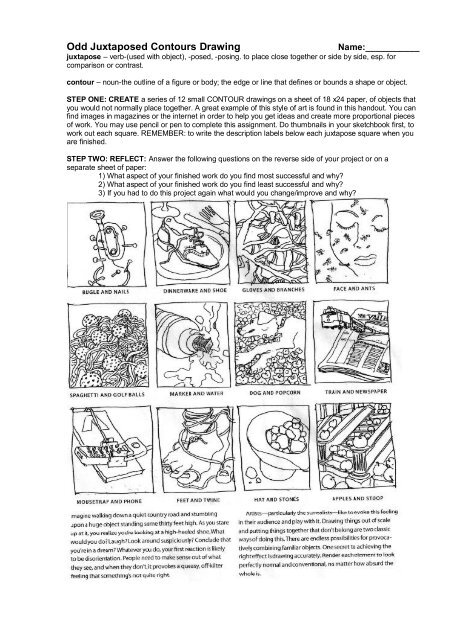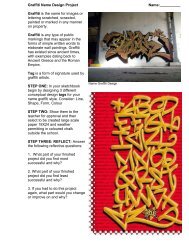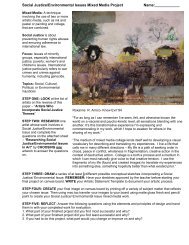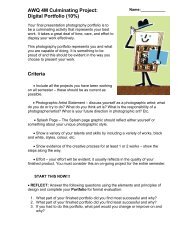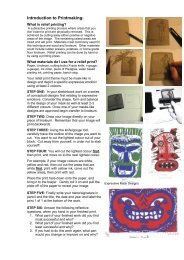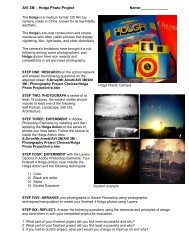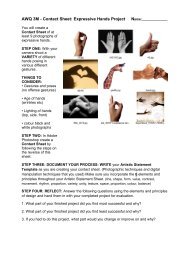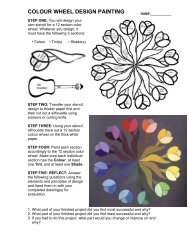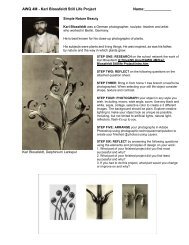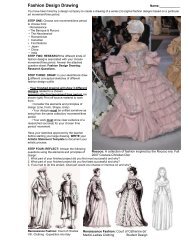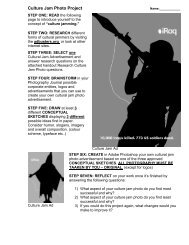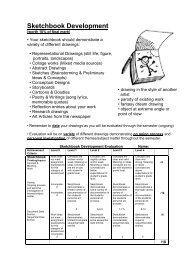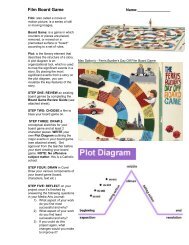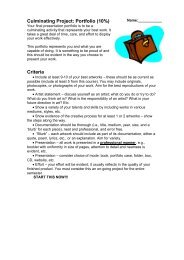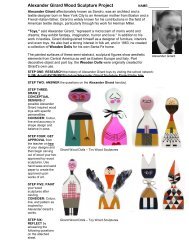Odd Juxtaposed Contours Drawing (.PDF)
Odd Juxtaposed Contours Drawing (.PDF)
Odd Juxtaposed Contours Drawing (.PDF)
You also want an ePaper? Increase the reach of your titles
YUMPU automatically turns print PDFs into web optimized ePapers that Google loves.
<strong>Odd</strong> <strong>Juxtaposed</strong> <strong>Contours</strong> <strong>Drawing</strong> Name:___________<br />
juxtapose – verb-(used with object), -posed, -posing. to place close together or side by side, esp. for<br />
comparison or contrast.<br />
contour – noun-the outline of a figure or body; the edge or line that defines or bounds a shape or object.<br />
STEP ONE: CREATE a series of 12 small CONTOUR drawings on a sheet of 18 x24 paper, of objects that<br />
you would not normally place together. A great example of this style of art is found in this handout. You can<br />
find images in magazines or the internet in order to help you get ideas and create more proportional pieces<br />
of work. You may use pencil or pen to complete this assignment. Do thumbnails in your sketchbook first, to<br />
work out each square. REMEMBER: to write the description labels below each juxtapose square when you<br />
are finished.<br />
STEP TWO: REFLECT: Answer the following questions on the reverse side of your project or on a<br />
separate sheet of paper:<br />
1) What aspect of your finished work do you find most successful and why?<br />
2) What aspect of your finished work do you find least successful and why?<br />
3) If you had to do this project again what would you change/improve and why?
<strong>Odd</strong> <strong>Juxtaposed</strong> <strong>Contours</strong> <strong>Drawing</strong> Rubric Name:__________<br />
Knowledge/<br />
Understanding<br />
Demonstrates<br />
understanding of the<br />
elements & principles<br />
of design in the<br />
drawing (e.g. shape,<br />
form, line, proportion<br />
unity)<br />
Thinking/<br />
Inquiry<br />
Depicts odd juxtapose<br />
contours employing<br />
representational<br />
imagery<br />
Communication<br />
Reflective Questions:<br />
Strength, Weakness &<br />
Next Step<br />
Application<br />
Creative Process:<br />
Ability to solve a series<br />
of artistic problems,<br />
showing an awareness<br />
of formal qualities,<br />
visual conventions, and<br />
relevant ideas and<br />
concepts.<br />
Preliminary Sketches.<br />
(3)<br />
Creative Process:<br />
Demonstration of Skill<br />
Development &<br />
following procedures<br />
including Clean Up<br />
Uses elements &<br />
principles of design<br />
and drawing<br />
techniques to produce<br />
an effective artwork<br />
(proportion, shape,<br />
line, etc.)<br />
Variety of <strong>Contours</strong><br />
(Shape and line)<br />
Level 0<br />
Work does not<br />
meet<br />
assignments<br />
expectations for<br />
this category.<br />
Incomplete.<br />
0<br />
Work does not<br />
meet<br />
assignments<br />
expectations for<br />
this category.<br />
Incomplete.<br />
0<br />
Work does not<br />
meet<br />
assignments<br />
expectations for<br />
this category.<br />
Incomplete.<br />
0<br />
Work does not<br />
meet<br />
assignments<br />
expectations for<br />
this category.<br />
Incomplete.<br />
0<br />
Incomplete.<br />
0<br />
Incomplete.<br />
0<br />
Incomplete.<br />
0<br />
Level 1<br />
Student<br />
demonstrates<br />
limited<br />
understanding of<br />
the elements &<br />
principles of design<br />
in the drawing.<br />
0.25<br />
Student depicts<br />
odd juxtaposed<br />
contour<br />
representational<br />
imagery in the<br />
drawing with<br />
limited<br />
effectiveness.<br />
0.25<br />
Poor, yes/no<br />
answers/limited<br />
incomplete.<br />
0.25<br />
Preliminary<br />
sketches are<br />
poor/incomplete.<br />
Concepts are<br />
poor/incomplete.<br />
Planning is<br />
tentative or nonexistent.<br />
(0.5)<br />
0.5<br />
Student<br />
demonstrates<br />
limited<br />
effectiveness in<br />
demonstrating the<br />
creative process<br />
and following<br />
procedures.<br />
5<br />
Student<br />
demonstrates<br />
limited use of the<br />
elements &<br />
principles of design<br />
& drawing<br />
techniques to<br />
produce an art<br />
work of limited<br />
effectiveness.<br />
1<br />
Work<br />
demonstrates<br />
limited variety of<br />
contours, shapes<br />
and lines. The<br />
composition does<br />
not contain<br />
sufficient value.<br />
1<br />
Level 2<br />
Student demonstrates<br />
some understanding<br />
of the elements &<br />
principles of design in<br />
the drawing.<br />
0.50<br />
Student depicts odd<br />
juxtaposed contour<br />
representational<br />
imagery in the<br />
drawing with some<br />
effectiveness.<br />
0.50<br />
Somewhat coherent<br />
and somewhat<br />
complete.<br />
0.50<br />
Preliminary sketches<br />
are somewhat clear<br />
and complete.<br />
Concepts are<br />
somewhat complete.<br />
Planning is somewhat<br />
substantial & shows<br />
some alternative<br />
ideas. (1-2)<br />
1<br />
Student demonstrates<br />
some effectiveness in<br />
demonstrating the<br />
creative process and<br />
following procedures.<br />
5-6<br />
Student demonstrates<br />
some use of the<br />
elements & principles<br />
of design & drawing<br />
techniques to produce<br />
an art work of some<br />
effectiveness.<br />
2-3<br />
Work demonstrates<br />
some variety of<br />
contours, shapes and<br />
lines. The<br />
composition is grey<br />
overall or contains<br />
minimal value to<br />
reflect 3-<br />
dimensionality.<br />
2<br />
Level 3<br />
Student demonstrates<br />
considerable<br />
understanding of the<br />
elements & principles<br />
of design in the<br />
drawing.<br />
0.75<br />
Student depicts odd<br />
juxtaposed contour<br />
representational<br />
imagery in the<br />
drawing with<br />
considerable<br />
effectiveness.<br />
0.75<br />
Clear and substantial<br />
answers.<br />
0.75<br />
Preliminary sketches<br />
are mostly complete.<br />
Concepts are<br />
complete. Planning is<br />
evident & shows<br />
some divergent<br />
thinking is evident. (2-<br />
3)<br />
1-1.75<br />
Student demonstrates<br />
considerable<br />
effectiveness in<br />
demonstrating the<br />
creative process and<br />
following procedures.<br />
7-8<br />
Student demonstrates<br />
considerable use of<br />
the elements &<br />
principles of design &<br />
drawing techniques to<br />
produce an art work<br />
of considerable<br />
effectiveness.<br />
3-4<br />
Work demonstrates<br />
considerable variety<br />
of contours, shapes<br />
and lines. The<br />
composition contains<br />
sufficient value to<br />
reflect 3-<br />
dimensionality.<br />
3 - 4<br />
Level 4<br />
Student<br />
demonstrates<br />
a high degree of<br />
understanding of<br />
the elements &<br />
principles of design<br />
in the drawing.<br />
1<br />
Student depicts<br />
odd juxtaposed<br />
contour<br />
representational<br />
imagery in the<br />
drawing with a high<br />
degree of<br />
effectiveness.<br />
1<br />
Superior and<br />
insightful answers.<br />
1<br />
Preliminary<br />
sketches are<br />
thorough &<br />
complete.<br />
Concepts are fully<br />
developed.<br />
Planning is<br />
exceptional &<br />
considerable<br />
flexibility in<br />
thinking. (3+)<br />
2<br />
Student<br />
demonstrates<br />
superior<br />
effectiveness in<br />
demonstrating the<br />
creative process<br />
and following<br />
procedures.<br />
8- 10<br />
Student<br />
demonstrates a<br />
high degree of<br />
using the elements<br />
& principles of<br />
design & drawing<br />
techniques to<br />
produce a highly<br />
effective art work.<br />
5<br />
Work<br />
demonstrates<br />
superior variety of<br />
contours, shapes<br />
and lines. The<br />
composition<br />
contains balanced<br />
value.<br />
5<br />
A1. The Creative Process: apply the creative process to create a variety of artworks, individually and/or collaboratively;<br />
A1.1 use various strategies, individually and/or collaboratively, with increasing skill to generate, explore, and elaborate on original ideas<br />
and to develop, reflect on, and revise detailed plans for the creation of art works that address a variety of creative challenges (e.g., extend<br />
their skills in using brainstorming, concept webs, mind maps, and/or groups discussions to formulate original and innovative ideas for an art<br />
work on a social or personal theme; use critical research skills to explore and elaborate on ideas; demonstrate fluency in formulating clear<br />
and detailed plans; demonstrate flexibility in revising their plans on the basis of reflection)<br />
A1.2 apply, with increasing fluency and flexibility, the appropriate stages of the creative process to produce two- and three-dimensional art<br />
works using a variety of traditional and contemporary media (e.g., extend their skills in working with a range of media; demonstrate<br />
flexibility in revising plans in response to problems encountered during other stages of the creative process; reflect on the effectiveness of<br />
preliminary versions of their work, and revise the work on the basis of reflection and self-assessment)<br />
A1.3 document their use of each stage of the creative process, and provide evidence of critical inquiry, in a portfolio that includes a range<br />
of art works created for a variety of purposes (e.g., ensure that their portfolio includes the following: evidence of critical inquiry associated<br />
with idea generation and elaboration; evidence of research on how different artists approach specific themes and/or use particular<br />
/1<br />
/1<br />
/1<br />
/2<br />
/10<br />
/5<br />
/5<br />
/25
techniques that can be adapted in their own work; preliminary and final works to show evidence of thoughtful revision), and review and<br />
reflect on the contents of their portfolio to determine how effectively they have used the creative process<br />
A2. The Elements and Principles of Design: apply the elements and principles of design to create art works for the purpose of self-expression<br />
and to communicate ideas, information, and/or messages;<br />
A2.1 apply the elements and principles of design with increasing skill and creativity to produce two- and three-dimensional art works that<br />
express personal feelings and communicate specific emotions (e.g., extend their skills in combining various elements and principles to<br />
convey a sense of fear, happiness, hopefulness, despair)<br />
A2.2 apply the elements and principles of design as well as a wide range of art-making conventions with increasing skill and creativity to<br />
produce art works that comment and/or communicate a clear point of view on a variety of issues (e.g., extend their skills by manipulating<br />
elements and principles and using conventions in creative ways to produce an art work that conveys the point of view of a teenager living<br />
on the street or that comments on a current event or social issue)<br />
A3. Production and Presentation: produce art works, using a variety of media/materials and traditional and emerging technologies, tools, and<br />
techniques, and demonstrate an understanding of a variety of ways of presenting their works and the works of others.<br />
A3.1 use with increasing skill a wide variety of media, including alternative media, and current technologies to create two- and threedimensional<br />
art works for a variety of purposes (e.g., extend their skills in the manipulation of a variety of media and technologies to create<br />
a sculpture for an outdoor space, a mixed-media work for display on the Internet, an installation evoking their cultural heritage)<br />
A3.2 use with increasing skill a wide variety of traditional and current materials, technologies, techniques, and tools to create original art<br />
works for a variety of purposes and audiences<br />
B1. The Critical Analysis Process: demonstrate an understanding of the critical analysis process by examining, interpreting, evaluating, and<br />
reflecting on various art works;<br />
B1.1 demonstrate the ability to support their initial responses to a variety of art works with informed understanding of the works’ artistic<br />
form and function (e.g., describe their initial response to an art work, and explain in detail how specific aspects of the work’s content,<br />
formal qualities, and media inform that response)<br />
B1.2 deconstruct with increasing skill and insight the visual content and the use of elements and principles of design in their own art<br />
work and the work of others (e.g., extend their skills in identifying individual elements and principles and aspects of the visual content in<br />
an art work, interpreting their function, and analysing their effect; compare and contrast the use of shape, form, line, texture, space, and<br />
balance in Frank Lloyd Wright’s Falling Water and Moshe Safdie’s Habitat)<br />
B1.4 describe in detail and reflect on with increasing insight the qualities of their art works and the works of others, and evaluate the<br />
effectiveness of these works using a wide variety of criteria (e.g., provide an informed explanation of why a work of art is, or is not,<br />
successful with respect to its ability to communicate a message or emotion, its technical and aesthetic conventions, its form and stylistic<br />
qualities, its originality)<br />
C1. Terminology: demonstrate an understanding of, and use correct terminology when referring to, elements, principles, and other components<br />
related to visual arts;<br />
C1.1 extend their understanding of the elements and principles of design, and use terminology related to these elements and principles<br />
correctly and appropriately when creating or analysing a variety of art works (e.g., when analysing how artists’ manipulation of space,<br />
movement, form, and proportion affects meaning in an installation or an environmental work)<br />
C1.2 explain in detail terminology related to a wide variety of techniques, materials, and tools (e.g., techniques and materials associated<br />
with installation art; additive and subtractive techniques, digital manipulation, impasto, optical colour mixing, pointillism), and use this<br />
terminology correctly and appropriately when creating, analysing, and/or presenting art works<br />
C1.3 explain in detail the stages of the creative process and the critical analysis process, and explain, using appropriate terminology,<br />
how these processes contribute to the successful creation and analysis of art works<br />
C2. Conventions and Techniques: demonstrate an understanding of conventions and techniques used in the creation of visual art works;<br />
C2.1 extend their understanding of a wide variety of techniques that artists use to achieve a range of specific effects (e.g., techniques<br />
used to create a range of textures in an art work, to develop the connection and relationship between forms in a composition, to draw<br />
attention to specific parts of a work)<br />
C2.2 extend their understanding of the variety of conventions used in visual art (e.g., allegory, appropriation, juxtaposition, synectics;<br />
conventions associated with formalism, objective and non-objective abstraction, propaganda, realism, social commentary), and explain<br />
in detail how they are used in a variety of art works<br />
C3. Responsible Practices: demonstrate an understanding of responsible practices in visual arts.<br />
C3.2 demonstrate appropriate health and safety procedures and conscientious practices in the selection and use of various materials,<br />
techniques, tools, and technologies when producing or presenting art works (e.g., demonstrate safe practices when creating<br />
installations, assemblages, earthworks, constructions, multimedia projects; demonstrate appropriate protocols, deportment, and<br />
respect for others when working in a studio or visiting a presentation space)


